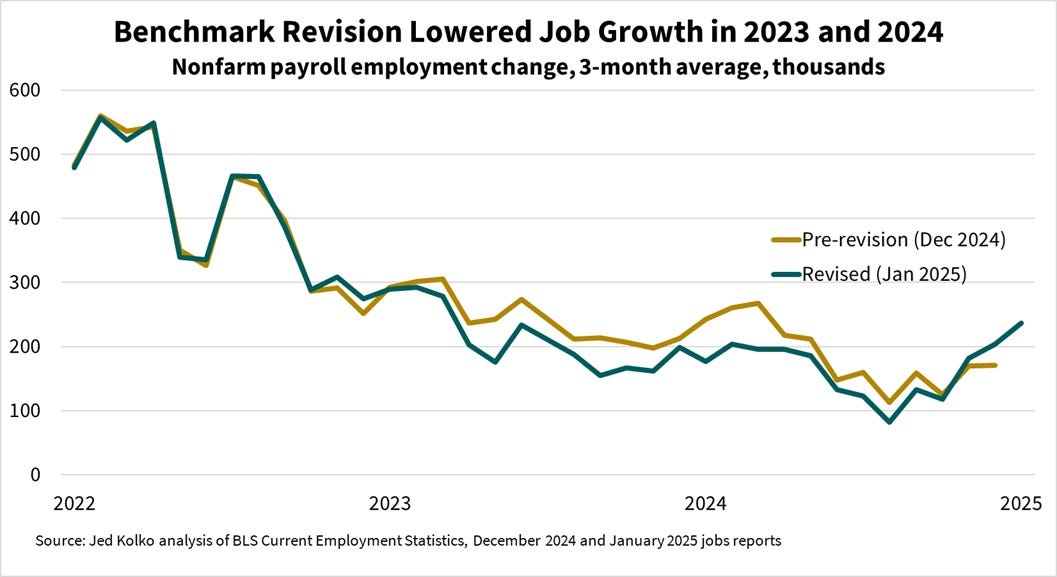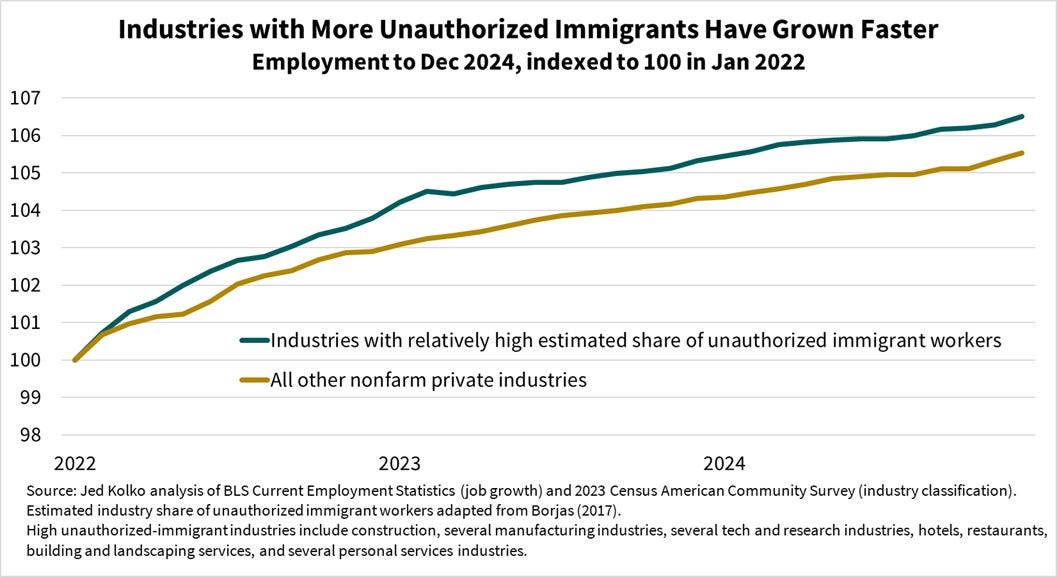Three must-knows from today's big-deal jobs report
The job market looks comfortably cool; beware hot takes about immigrants; and you can trust our statistical system.
This morning we got the jobs report we’ve been waiting for, with the annual benchmark revision to the payroll survey and the annual population adjustment to the household survey. The big news from this jobs report is not the month-to-month changes, but rather how the revisions and adjustments shift our underlying view of the labor market.
The first thing to know is that the job market is cooler than previously reported. As foreshadowed last August, average monthly job growth was revised downward from 251,000 to 216,000 in 2023, and from 186,000 to 166,000 in 2024. Whether job growth is too fast and risks overheating the market and pushing up inflation, or too slow and risks pushing up unemployment, depends on how job growth compares with the growth of the labor force. Unfortunately, the annual adjustment to the household survey is not applied historically, so you aren’t supposed to compare labor force estimates over time. But I did a quick-and-dirty simulation in order to do just that. It shows that the big upward adjustment to the population implies that the labor force grew by 150,000 people per month on average in 2024, versus 90,000 as officially reported.
All told, revised job growth of 166,000 per month in 2024 was only slightly above my adjusted estimate of labor force growth of 150,000 per month, even though the pre-revised and unadjusted data showed that monthly job growth of 186,000 ran far ahead of monthly labor force growth of 90,000. The labor market is therefore at less risk of overheating than last month’s numbers suggested.
The second thing to know is that you should ignore any hot takes about the size or growth in the native-born and foreign-born workforces. For fascinating but arcane technical reasons, household survey estimates of the number of native- and foreign-born workers are not accurate — neither the level nor the changes.
The jobs report offers better ways to understand immigration and the labor market. First, unemployment rates for native-born and foreign-born workers show how both groups are faring. In January, the unemployment rate for native-born workers was 4.3%, up from 4.0% a year ago; for foreign-born workers, it was 4.6%, up just a bit from 4.5% a year ago. Second, payroll job growth in industries that are estimated to employ a higher share of unauthorized immigrants has grown faster than other industries since early 2022, though the growth rates have been similar over the past year. This chart could look very different in the coming months if immigration declines or deportations increase.
The third thing to know is that you can trust these data. There was nothing surprising or unanticipated in the timing, methodology, direction, or size of these annual revisions and adjustments. In fact, these annual updates brought the two halves of the jobs report back into alignment. The upward adjustment to employment in the household survey and the downward revision to employment in the payroll survey closed most of the gap in reported employment between the surveys that opened in recent years. Once again, US statistical revisions are trustworthy.
This was a rough week for users of government data. On many official websites, including the Census Bureau, many datasets were suddenly inaccessible with no explanation. Some data have been restored, but data users are rightly on edge. It’s honestly a relief to see the jobs report posted on time this morning, with all the same tables as we’re accustomed to. Regardless of what happened in the labor market last month, that makes this jobs report a great jobs report.




The best news in this column is that you were able to get the data for this. I work with librarians who use the US Census data a lot in their work, and the recent weeks have been stressful.
Re: Census Data
I've seen the reporting on this, and I gotta say it confirms something I (as as a demographics geek/hobbyist) had been fearing.
What do Republicans have against counting people?